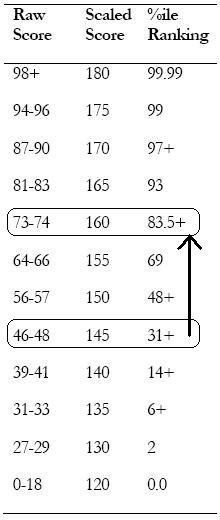Running Out of Time on the LSAT Test
This series of lesson articles discusses what to do if you find yourself running out of time on the LSAT test. It covers the following articles:
Running Out of Time on the LSAT Test: Introduction
LSAT Guessing Strategies
LSAT Time Management
Running out of Time on the LSAT Test
Running out of time on one or more sections on the LSAT is a common problem. Even those who score high on practice LSAT tests may not get to a few of the questions. There are only two things you can do if you find that you are running out of time on the LSAT test:
- Learn the LSAT inside and out, and,
- Master time management on the LSAT test.
The majority of your work through the TestSherpa LSAT course involves learning the LSAT test inside and out. It is the hardest of the two options, but is unavoidable. It involves many hours of reading our lessons and practices your new skills on released and other practice tests. It is the only way to a top score.
What if I only have a few weeks before the test? If you don’t have the time to put into serious study, you may be able to improve your score up to a 160 or more simply by learning better time management for the LSAT Test, even if you’re not 100% sure about each of your answers. Sound impossible? It isn’t.
One of the hardest strategies for TestSherpa students to embrace is guessing and skipping. Even unskilled test takers understand that, since there is no penalty for wrong answers on the LSAT, you should leave no question unanswered; however, a good guessing strategy can go far beyond simply filling in answers at random. In fact, a good guessing strategy combined with the most elementary understanding of LSAT question styles can quickly add as many as 25 or 30 points to your raw score.

Let’s assume that you scored a 145 on your diagnostic and want to jump to at least a 160 by test day. That’s a 15-point jump. Not only that, jumping from a 145 to a 160 means you jumped in percentile ranking past over half of all test takers to a whopping 83.5 percentile score. Does it seem impossible? It isn’t. Simply knowing how to guess right could lift your score that high.
Look at it this way: starting with a 145 means you’re already getting half the questions right. As you took the diagnostic, you probably noticed that many of the answer choices came down to two or three possible answers per question. That is to say, for most LSAT questions you can eliminate enough wrong answers to come down to two answer choices, the right answer, and the next most tempting answer. With a 145, you already have half of the test answered correctly. If on the other half, the tough half, you can eliminate all but two of the answers, you could jump to a 160 by flipping a coin between them.
Since there is no penalty for wrong answers, if you eliminate all of the tough questions down to the right answer and the next most tempting answer, on average you will get one out of every two tough questions right. That’s getting at least another 25 questions right just for knowing how to eliminate bad answers.
So here’s a sneaky trick we just played: you will need to put a little bit of study into how the wrong answers on the LSAT are created so that you get better at eliminating them. It’s a plan B form of attack. You are much better off knowing what the right answer should be based on your hours of experience with the LSAT. Then you could form a prephrase of that answer, scan for it, mark it, and be done without having to read any more answer choices. The time you save there can be used for harder questions. But you don’t always know immediately what the right answer is, so you switch to plan B. Plan B is knowing how to eliminate at least two, better yet three of the wrong answers so you have a 50% chance of getting the answer right. That is the difference between a 145 and a 160, so if you only have a limited amount of time, study the wrong answer choices well.
In the next article in this lesson, we’ll cover LSAT guessing strategies.
